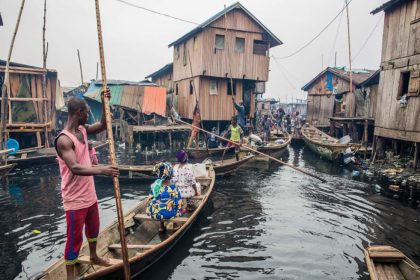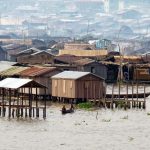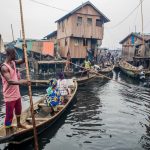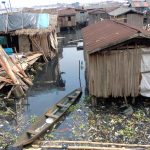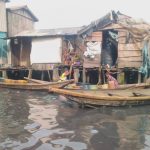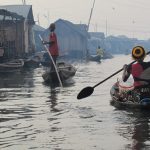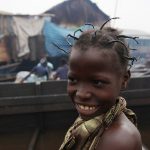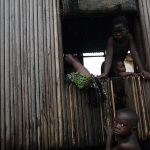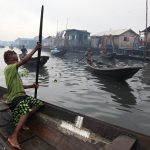Special Report after 10 months Investigation:
Survival Inside MAKOKO: Africa’s largest fishing village where 400,000 Nigerians live on water, land
…Children attend school on floating river, Slum has little access to electricity or clean sanitation
*Every 15 households share communal latrines, as excreta, kitchen waste and polythene bags go straight into the water
*Community speak in ‘Egun’ language traceable to descendants of Benin republic and Badagry-a coastal town in Lagos State
*BY GEORGE ELIJAH OTUMU/INTERNATIONAL INVESTIGATIVE Editor who was in Lagos, Nigeria
MAKOKO is more of a rusty community, with planks, schools, restaurants, barbing salons and fishing activities-all happening at the same time on a floating river. There has never been a dull moment in the lifestyle of the people of this community. This Africa’s largest slum also prides itself in floating clinics where the sick people are being given medical attention to their various ailments.
After 10 months of undercover investigation, it was discovered that Makoko, situated on Lagos mainland, Nigeria, is a large low-income community with half the population on water and half on land.
Although Makoko dates back to the 18th century, when it was established as a fishing village, the area is still considered an informal settlement with very limited government presence. Makoko’s main language is Egun, which is spoken in parts of both Benin and Nigeria. Makoko, known as the “Venice of Africa”, is a labyrinthine slum built on stilts and navigated by canoe. The slum has little access to electricity or clean sanitation, but it has also been home to innovations like the Makoko Floating School, a structure resting on recycled empty plastic barrels for buoyancy. There had been lots of controversy surrounding the date Makoko was conceived. Nevertheless, the majority of scholars believe Mokoko was established as a ‘Fishing Village’ from the outset.
Over the many years, thousands of people have made this place their home. Like many other ‘slums’, the houses on water are built from hardwood, supported by wood stilts driven deep into the waterbed. Each house usually houses between six to ten people and a high percentage are rental properties. The waters are five feet deep. Water meanders through the water settlement like streets in between houses. These ‘streets’ act as a road system, where you can find canoes carrying children to school and people to their places of work. As well as a form of transportation, canoes are used for fishing and act as points of sale; where women sell food, water and household goods. The main economic activities are salt making, sand dredging, sawmills, firewood, and fishing.
The Baal
e (chief of the village) on land estimates that there are approximately 400,000 people living in Makoko (water and land) and the World Bank estimates that the population on land is just over 85,000. There has never been an official population count on water because the settlement is considered non-existent and illegal. The majority of the residents come from the Egun tribe of Benin Republic and Badagry, a coastal town in Lagos State that borders the neighbouring country, Benin.
The settlement lacks basic social amenities such as electricity, schools, and healthcare clinics. The residents lack sufficient sanitation. Interaction with some of the residents showed that communal latrines are shared by 15 households while excreta, kitchen waste and polythene bags go straight into the water. In Makoko, there are two ways to get potable water: the first is to buy it from vendors and the second is to fill up plastic jerry cans from large plastic tanks that are situated at different points in the settlement. Residents spoken to, confirmed that the Local Government provides some plastic tanks, as others are owned for the sale of water. These tanks are connected to boreholes or underground pipes.
The area is self-policed; rarely seen by policemen in the settlement. The community has a low crime rate. The fertility rate is high and a high percentage of residents are illiterate. A recent research reportedly said “’Five in every 20 persons below the age of 30 are stark illiterate, while 14 are educated to primary or secondary level”.
For the records, in July 2012, more than 200 people were made homeless when the government issued a demolition exercise of the Makoko waterfront communities. Then, a 72-hour Quit Notice was delivered to the residents and it stated that due to the environmental nuisance, security risk, impediment to economic and gainful utilisation of the waterfront, people who own shanties should vacate the area. Police and state government staff arrived using machetes to cut down the stilts of the wooden homes on water. At that time, no alternative accommodation was offered to the residents. The demolition was halted on July 21, 2012 after 5 days; in which, a community leader was shot by a police officer.
With only a 72 hour notice, some of the displaced residents were taken in by their neighbours, some had few of their possessions, left their children in canoes and others rebuilt in the allocated boundary of 100 metres from the electricity cables. Being a health and an environmental hazard and as out of line with the Lagos State’s development plans, the government felt encouraged to undergo the demolition exercise on the water settlements.
Furthermore, the residents were understood to be in danger because of the electricity cables that run along the shanties on the water, rising water levels, thunderstorms, and heavy rainfall. The environment is also seen to be degrading; due to waste being dumped into the lagoon and the haphazardness of the settlement.
Lagos State Government also believes that Makoko is an “impediment to the economic and gainful utilisation of the waterfront and it undermines the ‘megacity status that Lagos is trying to achieve”. Another reason for the demolition exercise in 2012, which was not highlighted in reports, but sometimes mentioned vaguely, is the potential the land has for the growing population of Lagos.
At the time of the demolition, neither the public nor the media had access to a proposal or detailed development plan for Makoko. Over 20 years, this slum went from being a low-income and under-developed area with shanties to become ‘mega expensive plots of land’ via the demotion and forced eviction undertaken by Lagos State Government .
Initially, the state government hinted at developing the area and relocating those who live on land. After a while, the government reneged on its promise to relocate the people, then degraded ‘illegal residents’ on water. In August 2012, the State government offered Agbowa, Ikorodu (North-east of Lagos) a relocation option for those displaced during the clearance exercise. However, the community rejected this because due to their trade, they need to be close to water. They explained during negotiations that living on the water is natural to them and it allows them to work. They also stated that Makoko is important to the economy of Lagos because the fish they catch is what feeds the whole state.
For instance, at the Makoko-Aseje market, the most popular market in Makoko are: seafood; croakers, barracudas, shiny-nose, red-snapper, prawns, crabs and more in large quantities, are sold at low prices. The Makoko community have not taken this lying down; they are in constant pleading with the government to move from ‘demolition’ to ‘development’.
Due to the media outcry and the community’s protest the Lagos State Governor through the Ministry of Physical Planning and Urban Development granted the wish of the community; and that is, to submit a regeneration plan developed by the Makoko waterfront communities. The regeneration plan was developed in collaboration with all five communities at the waterfront.
The holistic urban upgrading plan looks at all facets of life and development in Makoko Waterfront including land use, housing, tourism opportunities, economic development, tenure security, funding strategies and institutional framework for implementation and management.
Nicknamed by some as the “Venice of Africa,” the floating village of Makoko in Lagos, Nigeria, is inhabited by people who not only live on water, but also also depend on it for their livelihood. … Young men in Makoko are typically put to work building canoes, in business ventures supervised by elders.
Over the many years, thousands of people have made this place their home. Like many other ‘slum’ areas, the full population of Makoko is unknown because it is formally unrecognised. … There has never been an official population count on water because the settlement is considered non-existent and illegal.
Most evenings, Christy Imade can be found paddling her wooden canoe on the murky waters in Makoko, a waterfront community on the Lagos lagoon in Nigeria’s southwest. She stops in front of a church perched precariously on top of stilts. Holding the wooden paddle in one hand, she stretches the other to take a photo of the church. She then enters the coordinates into her phone. “I have lived here for all of my life and I still find places I have never seen,” Hounkpe said.
Her trips around the floating community dubbed the ‘Venice of Africa’ are part of a project that seeks to put the renowned slum on the digital map.
Makoko has a diverse and colorful history and was established when fishermen from nearby Togo and the Republic of Benin settled there about a century ago. Like much of Lagos, it is highly multicultural; conversations on the floating slum are usually in a language which is a peculiar medley of Yoruba, French, and Egun, a local dialect.
The slum which was initially just a place to fish has grown to be the home for generations of fishermen from neighboring countries. It is hard to tell how many people reside in Makoko as there has never been an official census carried out there, however, locals estimate more than one million. But the Lagos government would prefer that Makoko does not exist.
In 2012, the Lagos state government announced plans to demolish the slum and gave a 72-hour eviction notice to the residents. The stilt structures in the fishing community posed a security risk and undermined the megacity status of the city, Lagos state authorities said in a letter served to the community, local chief Victor Panke.
The government came with the police and soldiers to evacuate the community and destroy their homes, according to Panke. A community leader, Timothy Hunpoyanwha, was shot dead by police which led the authorities to pause on the eviction process, Panke said.
Since then, he says Makoko has received subtle threats of eviction and they are watching keenly as other waterside communities are demolished. “We are still living in the fear of losing our homes and land,” he added.
Lagos Commissioner for Physical Planning & Urban Development Idris Salako reportedly said that authorities in the state were not behind the eviction of residents in waterfront communities but gave no further details or comment in his response to the allegations. The digital mapping project is going some way to allay the fears of Makoko locals who are worried their land is at risk.
Launched in September 2019 by Code for Africa in partnership with Humanitarian Open Street Map is working to put Makoko on digital maps in a bid to drive social and financial inclusion.
“We want the community, like other communities in the world, to be available and navigable on maps. From there, new development plans might come” Jacopo Ottaviani, Chief Data Officer Code For Africa told this correspondent.
To take up this project, young residents of Makoko were taught to pilot drones and populate the map with images from the community. Hounkpe is one of the residents on the project that is also teaching residents how to fly drones.
For generations, the people of Makoko have lived in houses perched on stilts above the lagoon that prompted Portuguese colonialists to christen this city Lagos centuries ago. Residents navigate dugout canoes through a maze of brown waterways that spread far beneath the longest bridge in Africa, which connects the creek-filled islands of Lagos with its crowded mainland.
Some see the community balanced on water as an engineering feat that is almost as impressive as the bridge that passes by it, albeit less planned. An estimated 250,000 people live in Makoko; they trade, shop and build aqua-farms on the lagoon’s waters.
“Like everybody passing over (Lagos city’s)Third Mainland Bridge, I became interested in Makoko,” said Kunle Adeyemi, a Nigerian architect who is based in the waterside city of Amsterdam. While Makoko is largely self-sufficient, the entire community is served by a single primary school. Adeyemi’s visit to the area in 2009 gave him the idea of building a floating settlement
As climate change pushes up sea levels and coastal erosion chips away at the shoreline, thousands of homes built along west Africa’s densely populated coast are washed away each year. Each year, the tropical rains that lash Lagos overwhelm the colonial-era drainage system. During rainy seasons, fishermen sometimes canoe across roads sunk under floodwaters.
How Africa’s largest city reacts to the encroaching waters is a crucial test case for other countries. “The big question is what will Lagos look like in 50 years’ time? Will we have a city that integrates water into its design, or will we have a city that tries to keep water out at any cost?” said Janthomas Hiemstra, deputy country director for the United Nations Development Fund, as he stood on a floating platform like the one on which the proposed Makoko school could be built.
It is a question authorities are grappling with in the main city of a country whose current growth rate could push its population to 300 million within a quarter of a century. “A floating school like this could be part of a vision for Lagos,” said Hiemstra.
Amid a torrential downpour, children and adults alike leap onto the platform, which is made of locally sourced wood and kept afloat by bright blue recycled plastic barrels. “We looked at many ways of creating a building that would still be functional regardless of the water levels, and we decided the building should float,” said Adeyemi, as the platform swayed gently in the waters.
Under the plan, 16 such podiums would be lashed together to form the ground floor of the school. The proposed three-storey triangular structure would address some of the infrastructure problems that plague the communities in Lagos that live on the water, said Adeyemi. Solar panels would provide renewable energy; the sloping roof would enable rainwater to be harvested efficiently, and a waste-to-energy system would solve sanitation problems.
Adeyemi added: “The building can be adapted for other uses, such as homes or hospitals. Ultimately, it’s a vision that can be used to sustainably develop African coastal communities.”
Nevertheless, the floating school project has received tentative backing from local authorities, and Ayinde admitted that proposals for houses on water could still be part of a wider vision.
Not everyone living on the water wants to leave. A Makoko fisherman, Boyo Shemede, said: “I was born on these waters. If we leave the water, we will still be alive but we will never be truly happy. What we really want is for the government to help us with sanitation.”
In recent years, Lagos has begun exploiting its waters. More than 1 million Lagosians now use some form of water transport each month, and the city’s waterfront ministry has welcomed private investment in projects, such as the construction of Eko Atlantic city, on the southern tip of Lagos
Everyday life for the many fishermen and their families revolves around paddling and rowing through the filthy, oily water in the slum – but this does not stop the young children from beaming when they see a camera.
Authorities threatened to knock down the dilapidated homes, which are classed as ‘illegal’ buildings and have reportedly been branded an ‘environmental nuisance’. The threat, which was issued in July and gave residents just 72 hours notice, saw some homes reportedly having their stilts hacked off and shacks being destroyed.
The move struck fear in many of the dwellers’ hearts and they feared they would be left without shelter as they had nowhere to go or anyone to turn to. But, months after the reported demolition warning, a group is now planning on building a floating school, in a bid to improve the lives of the youngsters who live in Makoko.
The settlement, which is built on Lake Lagos, is regarded as an eyesore by authorities as it is built on a huge waterfront. Activists strongly criticised the clearance last year, saying the move would mean thousands would be displaced. The slum is visible from the bridge which connects the Nigerian mainland to the Lagos’ rich island districts, and the eradication of the slum is part of a plan to clean up Lagos and improve its image.
CERTAINLY, Good journalism costs a lot of money. Without doubt, only good journalism can ensure the possibility of a good society, an accountable democracy, and a transparent government. We are ready to hold every corrupt government accountable to the citizens. To continually enjoy free access to the best investigative journalism in Nigeria, we are requesting of you to consider making a modest support to this noble endeavor.
By contributing to NAIJA STANDARD NEWSPAPER, you are helping to sustain a journalism of relevance and ensuring it remains free and available to all without fear or favor.
Your donation is voluntary — please decide how much and how often you want to give. For offline donation, email: letters@nigeriastandardnewspaper.com or call +2348037128048 (Nigeria) or +16825834890 (United States of America)
[pff-paystack id=


